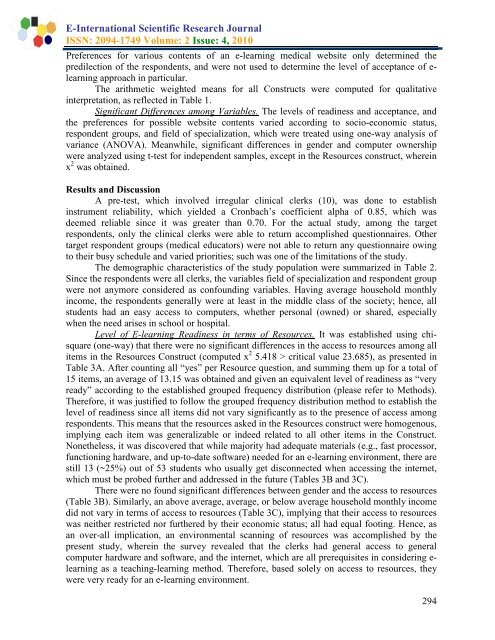download the full article here - EISRJC
download the full article here - EISRJC
download the full article here - EISRJC
Create successful ePaper yourself
Turn your PDF publications into a flip-book with our unique Google optimized e-Paper software.
E-International Scientific Research JournalISSN: 2094-1749 Volume: 2 Issue: 4, 2010Preferences for various contents of an e-learning medical website only determined <strong>the</strong>predilection of <strong>the</strong> respondents, and were not used to determine <strong>the</strong> level of acceptance of e-learning approach in particular.The arithmetic weighted means for all Constructs were computed for qualitativeinterpretation, as reflected in Table 1.Significant Differences among Variables. The levels of readiness and acceptance, and<strong>the</strong> preferences for possible website contents varied according to socio-economic status,respondent groups, and field of specialization, which were treated using one-way analysis ofvariance (ANOVA). Meanwhile, significant differences in gender and computer ownershipwere analyzed using t-test for independent samples, except in <strong>the</strong> Resources construct, w<strong>here</strong>inx 2 was obtained.Results and DiscussionA pre-test, which involved irregular clinical clerks (10), was done to establishinstrument reliability, which yielded a Cronbach’s coefficient alpha of 0.85, which wasdeemed reliable since it was greater than 0.70. For <strong>the</strong> actual study, among <strong>the</strong> targetrespondents, only <strong>the</strong> clinical clerks were able to return accomplished questionnaires. O<strong>the</strong>rtarget respondent groups (medical educators) were not able to return any questionnaire owingto <strong>the</strong>ir busy schedule and varied priorities; such was one of <strong>the</strong> limitations of <strong>the</strong> study.The demographic characteristics of <strong>the</strong> study population were summarized in Table 2.Since <strong>the</strong> respondents were all clerks, <strong>the</strong> variables field of specialization and respondent groupwere not anymore considered as confounding variables. Having average household monthlyincome, <strong>the</strong> respondents generally were at least in <strong>the</strong> middle class of <strong>the</strong> society; hence, allstudents had an easy access to computers, whe<strong>the</strong>r personal (owned) or shared, especiallywhen <strong>the</strong> need arises in school or hospital.Level of E-learning Readiness in terms of Resources. It was established using chisquare(one-way) that <strong>the</strong>re were no significant differences in <strong>the</strong> access to resources among allitems in <strong>the</strong> Resources Construct (computed x 2 5.418 > critical value 23.685), as presented inTable 3A. After counting all “yes” per Resource question, and summing <strong>the</strong>m up for a total of15 items, an average of 13.15 was obtained and given an equivalent level of readiness as “veryready” according to <strong>the</strong> established grouped frequency distribution (please refer to Methods).T<strong>here</strong>fore, it was justified to follow <strong>the</strong> grouped frequency distribution method to establish <strong>the</strong>level of readiness since all items did not vary significantly as to <strong>the</strong> presence of access amongrespondents. This means that <strong>the</strong> resources asked in <strong>the</strong> Resources construct were homogenous,implying each item was generalizable or indeed related to all o<strong>the</strong>r items in <strong>the</strong> Construct.None<strong>the</strong>less, it was discovered that while majority had adequate materials (e.g., fast processor,functioning hardware, and up-to-date software) needed for an e-learning environment, <strong>the</strong>re arestill 13 (~25%) out of 53 students who usually get disconnected when accessing <strong>the</strong> internet,which must be probed fur<strong>the</strong>r and addressed in <strong>the</strong> future (Tables 3B and 3C).T<strong>here</strong> were no found significant differences between gender and <strong>the</strong> access to resources(Table 3B). Similarly, an above average, average, or below average household monthly incomedid not vary in terms of access to resources (Table 3C), implying that <strong>the</strong>ir access to resourceswas nei<strong>the</strong>r restricted nor fur<strong>the</strong>red by <strong>the</strong>ir economic status; all had equal footing. Hence, asan over-all implication, an environmental scanning of resources was accomplished by <strong>the</strong>present study, w<strong>here</strong>in <strong>the</strong> survey revealed that <strong>the</strong> clerks had general access to generalcomputer hardware and software, and <strong>the</strong> internet, which are all prerequisites in considering e-learning as a teaching-learning method. T<strong>here</strong>fore, based solely on access to resources, <strong>the</strong>ywere very ready for an e-learning environment.294
















